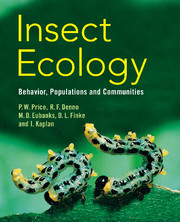Book contents
- Frontmatter
- Contents
- Preface
- Acknowledgments
- Part I Introduction
- Part II Behavioral ecology
- Part III Species interactions
- Part IV Population ecology
- 9 Demography, population growth and life tables
- 10 Life histories
- 11 Population dynamics
- Part V Food webs and communities
- Part VI Broad patterns in nature
- Glossary
- References
- Author Index
- Taxonomic Index
- Subject Index
- Plate section
- References
9 - Demography, population growth and life tables
from Part IV - Population ecology
Published online by Cambridge University Press: 05 June 2012
- Frontmatter
- Contents
- Preface
- Acknowledgments
- Part I Introduction
- Part II Behavioral ecology
- Part III Species interactions
- Part IV Population ecology
- 9 Demography, population growth and life tables
- 10 Life histories
- 11 Population dynamics
- Part V Food webs and communities
- Part VI Broad patterns in nature
- Glossary
- References
- Author Index
- Taxonomic Index
- Subject Index
- Plate section
- References
Summary
Demography has been defined as “The processes of birth, death, immigration and emigration that determine the size, fluctuations and age structure of populations. Also the study of these processes and their effects” (Calow 1998, p. 175). Thus, the science includes the study of the size and density of populations, their growth and decline, and their movements and distributions. The field emphasizes numbers of individuals and their ages, times of reproduction, fecundity and the time of death, concentrating on description rather than the whys and wherefores. Why populations fluctuate is addressed by the subject of population dynamics (Chapter 11).
In this chapter we will cover important ingredients of demography, which include how populations grow, how populations survive and how much they reproduce. Life tables are quantitative descriptions of population survival, which may also include the timing of births into the population, or fecundity schedules, and estimates of emigration and immigration. These kinds of information form the basis for the study of population dynamics, so that some of the elementary aspects of population dynamics are treated in this chapter.
- Type
- Chapter
- Information
- Insect EcologyBehavior, Populations and Communities, pp. 351 - 372Publisher: Cambridge University PressPrint publication year: 2011



